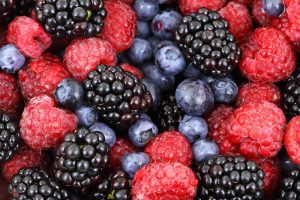Bulletin #4036, Let’s Preserve: Berries*

Bulletin #4036, Let’s Preserve: Berries (PDF)
Developed by Penn State Cooperative Extension with special project funds from Extension Service, U.S. Department of Agriculture.
For information about UMaine Extension programs and resources, visit extension.umaine.edu.
Find more of our publications and books at extension.umaine.edu/publications/.
Recommended Varieties
*All (except strawberries)
Quantity
A 24-quart crate weighs 36 pounds and yields 18 to 24 quarts. An average of 12 pounds makes a 7-quart canner load. An average of 7-1/2 pounds is needed per canner load of 9 pints. An average of 1 pound makes 1 pint of frozen berries.
Quality
Freeze berries and preserve them (except for blueberries) the same day of harvest for best quality. Refrigerate blueberries 1 or 2 days to improve their flavor, then preserve them. Select berries with fresh sweet flavor, deep colors, and firm textures, but of ideal maturity for eating fresh.
Preparation
Remove blossoms and stems, if appropriate. Snip off gooseberry heads and tails with scissors. Wash 1 or 2 quarts at a time and drain. Do not soak berries.
Freezing Procedure
Don’t freeze more than 2 pounds of food per cubic foot of freezer capacity per day. Berries may be packed with syrup or dry sugar.
To make a syrup pack, mix and dissolve 2-1/2 cups sugar in 4 cups of water. Add 1 cup of this syrup per quart of prepared fruit.
To make a dry pack, mix 1/2 cup dry sugar per quart of prepared fruit. To package, fill pint- or quart-size freezer bags 3 to 4 inches from their tops, and squeeze out air. Leave 1-inch headspace, seal, label, and freeze. Before freezing, bags may be inserted into reusable rigid plastic freezer containers for added protection against punctures and leakage.
Canning Procedure
Wash jars. Prepare lids according to manufacturer’s instructions. Berries in jars may be covered with your choice of water, apple or white grape juice, or more commonly with a very light, light or medium syrup. To make a very light syrup for a canner load of quarts, mix 1-1/4 cups of sugar in 10-1/2 cups water and heat to dissolve; or mix and dissolve 2-1/4 cups sugar in 9 cups water to make a light syrup; or 3-3/4 cups sugar in 8-1/4 cups water to make a medium syrup.
To make a hot pack, place drained berries in boiling syrup, juice, or water and boil 30 seconds. Fill clean jars with hot berries and cooking liquid, leaving 1/2-inch headspace.
To make a raw pack, place drained berries in jars and cover with your choice of boiling water, juice, or syrup, leaving 1/2-inch headspace. Wipe sealing edge of jars with a clean, damp paper towel. Add lids, tighten screw bands, and process jars.
To process in a boiling water canner, fill canner halfway with water and preheat to 180 degrees F for hot packs or 140 degrees F for raw packs. Load sealed jars into the canner rack and lower with handles; or load one jar at a time with a jar lifter onto rack in canner. Add water, if needed, to a level of 1 inch above jars. Add cover. When water boils vigorously, lower heat to maintain a gentle boil and process for recommended time.
After processing is completed, remove jars from canner with a jar lifter and place on a towel or rack. Do not retighten screw bands. Air-cool jars 12 to 24 hours. Remove screw bands and check lid seals. If the center of the lid is indented, wash, dry, label, and store jar in a clean, cool, dark place. If lid is unsealed, examine and replace jar if defective, use new lids, and process as before. Wash screw bands and store separately. Berries are best if consumed within a year and safe as long as lids remain vacuum sealed.
Process Times
| Style of Pack | Jar size | Minutes of processing time at altitudes of | ||
|---|---|---|---|---|
| 0 – 1000 ft. | 1001 – 6000 ft. | Above 6000 ft. | ||
| Hot |
Pints Quarts |
15 15 |
20 20 |
25 25 |
|
Raw |
Pints Quarts |
15 20 |
20 30 |
25 35 |
Nutritional Information
| Raw | Frozen | Canned | ||
|---|---|---|---|---|
| Unsweetened | Sweetened | Heavy Syrup | ||
| Calories | 41 | 39 | 94 | 112 |
| Carbohydrates, g | 10 | 9 | 25 | 28 |
| Fats, g | 0.2 | 0.4 | 0.1 | 0.4 |
| Protein, g | 0.4 | 0.3 | 0.4 | 0.8 |
| Sodium, mg | 4.5 | 0.5 | less than 2% | 4.0 |
| Vitamin C* | 15 | 2 | 2 | 2 |
*Expressed as percentage of the U.S. Recommended Daily Allowances (US RDA). Other vitamins contained at insignificant levels.
Information in this publication is provided purely for educational purposes. No responsibility is assumed for any problems associated with the use of products or services mentioned. No endorsement of products or companies is intended, nor is criticism of unnamed products or companies implied.
© 2000
Call 800.287.0274 (in Maine), or 207.581.3188, for information on publications and program offerings from University of Maine Cooperative Extension, or visit extension.umaine.edu.
In complying with the letter and spirit of applicable laws and pursuing its own goals of diversity, the University of Maine System does not discriminate on the grounds of race, color, religion, sex, sexual orientation, transgender status, gender, gender identity or expression, ethnicity, national origin, citizenship status, familial status, ancestry, age, disability physical or mental, genetic information, or veterans or military status in employment, education, and all other programs and activities. The University provides reasonable accommodations to qualified individuals with disabilities upon request. The following person has been designated to handle inquiries regarding non-discrimination policies: Director of Equal Opportunity and Title IX Services, 5713 Chadbourne Hall, Room 412, University of Maine, Orono, ME 04469-5713, 207.581.1226, TTY 711 (Maine Relay System).

